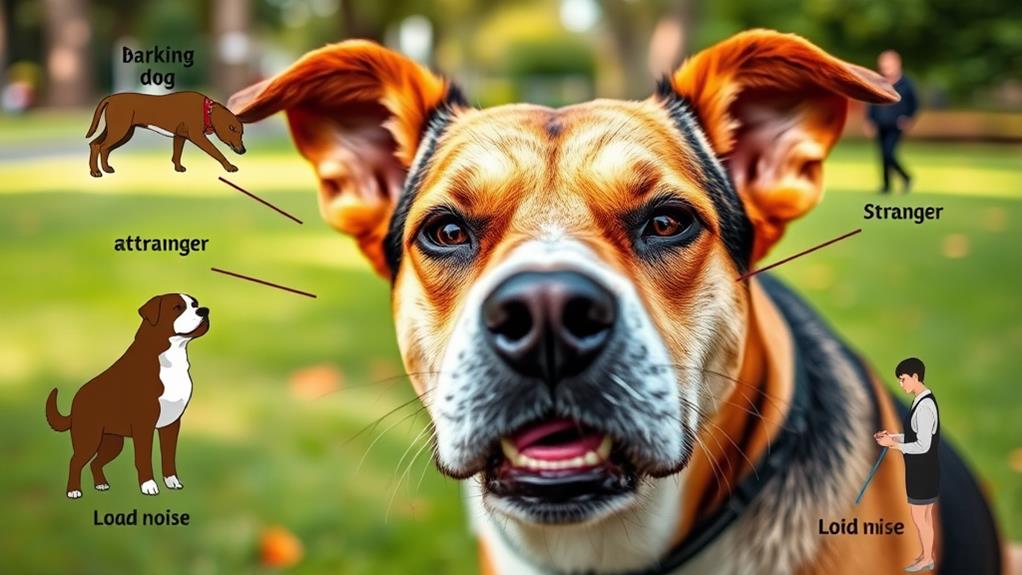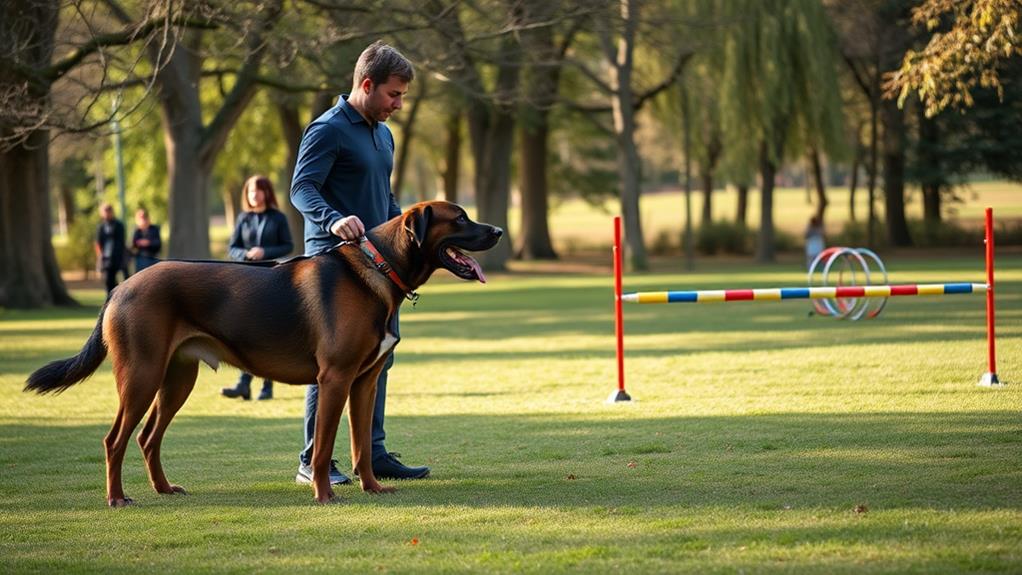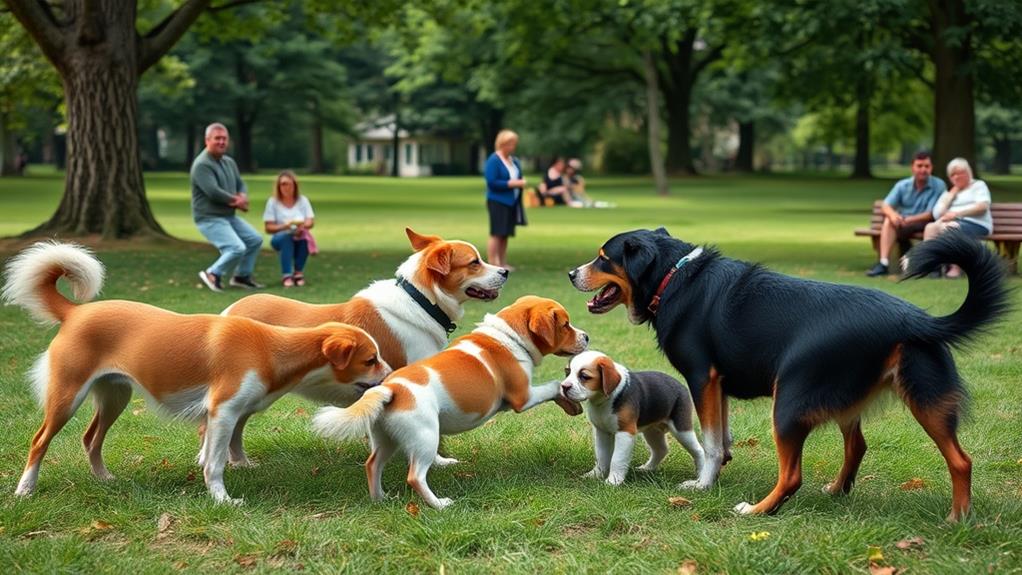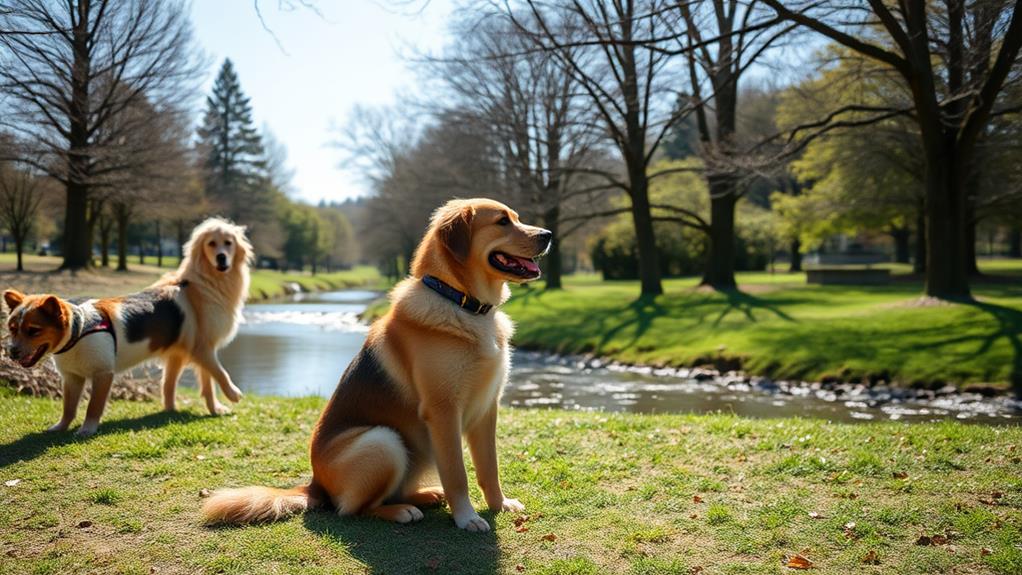To tame your aggressive dog, start by identifying triggers of aggression. Observe your dog's body language and keep a journal to recognize patterns. Next, use consistent training techniques. Reinforce basic commands like "sit" and "stay" with positive reinforcement, avoiding punishment. Finally, enhance socialization by exposing your dog to various environments, people, and other dogs. Arrange controlled interactions in positive settings to build their confidence. By following these tips, you'll create a balanced and well-adjusted dog. Discover even more effective strategies to nurture your furry companion in the next sections!
Identify Triggers of Aggression

Understanding your dog's triggers is crucial to managing aggressive behavior. By identifying what sets off your dog, you can take proactive steps to minimize those situations. Start by observing your dog's body language. Notice when they growl, bark, or show signs of tension. These behaviors often signal discomfort or fear, which can lead to aggression.
Next, consider the environments where aggression occurs. Is it at the dog park, during walks, or around specific people or animals? Keeping a journal can help you track these incidents, allowing you to see patterns over time. Look for common factors like loud noises, sudden movements, or unfamiliar faces.
Pay attention to your dog's interactions with others. Some dogs may react aggressively when approached too quickly or when their space is invaded. Recognizing these moments can help you intervene before aggression escalates.
Lastly, don't ignore the impact of your emotions. Dogs are sensitive to your feelings, so if you're anxious or stressed, your dog may become agitated. By understanding and addressing these essential triggers, you can create a safer environment for both you and your dog.
Consistent Training Techniques

Consistent training techniques are essential for curbing aggressive behavior in dogs. When you establish clear commands and expectations, your dog learns what's acceptable. Start by reinforcing basic obedience commands like "sit," "stay," and "come." These commands create a foundation for better behavior and help you maintain control in challenging situations.
Using positive reinforcement is key. Reward your dog with treats, praise, or play when they respond correctly to commands. This encourages them to repeat the desired behaviors. Consistency in your rewards is indispensable; if you sometimes reward a behavior and sometimes don't, your dog may become confused.
Set a regular training schedule to guarantee your dog knows when to expect training sessions. Short, frequent sessions are more effective than long, sporadic ones. Practice in various environments to help your dog generalize their training, which can reduce their aggressive reactions in different situations.
Lastly, be patient and avoid punishment. Harsh corrections can lead to fear and more aggression. Instead, focus on redirecting your dog's energy into positive behaviors. With consistent training, you'll create a well-behaved companion who feels secure and confident.
Socialization and Exposure

Socialization and exposure to various environments and experiences are crucial for reducing aggressive behaviors in dogs. By introducing your dog to different people, animals, and situations, you help them build confidence and learn how to respond appropriately. This can markedly diminish fear and anxiety, which often lead to aggression.
Socialization and exposure to various environments and experiences are essential for reducing aggressive behaviors in dogs. By introducing your dog to different people, animals, and situations, you help them build confidence and learn how to respond appropriately. This can substantially diminish fear and anxiety, which often lead to aggression.
| Activity | Benefits |
|---|---|
| Dog parks | Encourages play and interaction with other dogs. |
| Obedience classes | Teaches discipline and proper behavior around others. |
| Neighborhood walks | Exposes your dog to various sights, sounds, and smells. |
| Meet new people | Helps your dog become comfortable with unfamiliar faces. |
| Controlled playdates | Allows your dog to interact with known, friendly dogs. |
When you consistently implement these activities, your dog learns that new experiences aren't threats but opportunities for fun and growth. Remember, the earlier you start socializing your dog, the better. Even older dogs can benefit from these experiences, so don't hesitate to begin today. This proactive approach can lead to a more balanced and less aggressive companion.
Frequently Asked Questions
What Breeds Are More Prone to Aggressive Behavior?
Certain breeds, like Rottweilers, Pit Bulls, and German Shepherds, might show more aggressive tendencies. However, it is crucial to remember that individual temperament, training, and socialization greatly influence a dog's behavior, regardless of breed.
How Can I Tell if My Dog Is Aggressive?
Did you know that nearly 20% of dogs show aggression? To tell if your dog's aggressive, watch for growling, baring teeth, or stiff body posture. Trust your instincts; these signs often indicate discomfort or fear.
Should I Use a Muzzle for My Aggressive Dog?
Using a muzzle for your aggressive dog can be beneficial in certain situations. It helps keep everyone safe while you work on behavior modification. Just guarantee it's comfortable and allows for panting and drinking.
Can Neutering Help Reduce Aggression in Dogs?
Neutering can help reduce aggression in dogs by lowering testosterone levels, which influence territorial and dominance behaviors. However, it's not a guaranteed solution; training and socialization play essential/key/vital roles in managing aggression effectively.
Is Medication an Option for Aggressive Dog Behavior?
Imagine a dog named Max, whose aggression escalates during walks. Medication can help calm his anxiety and reduce aggressive behaviors, but it's essential to combine it with training and behavioral modification for lasting results.
Conclusion
By identifying triggers, employing consistent training, and ensuring proper socialization, you can transform your aggressive dog into a well-mannered companion. Understanding their fears, reinforcing positive behaviors, and exposing them to various environments can turn challenges into triumphs. With patience and dedication, you're not just training your dog; you're building trust, fostering confidence, and creating a harmonious bond. Remember, every step you take leads to a happier, healthier relationship with your furry friend.



